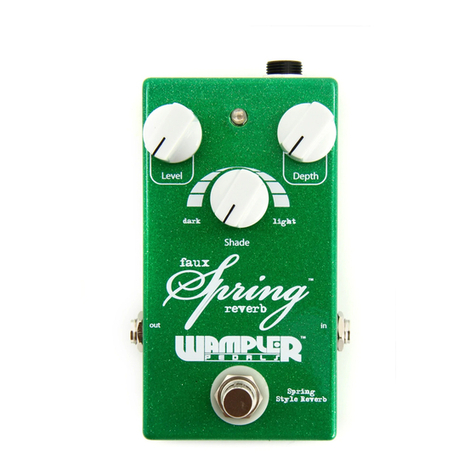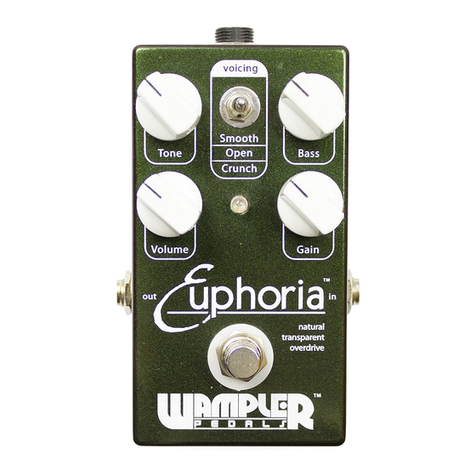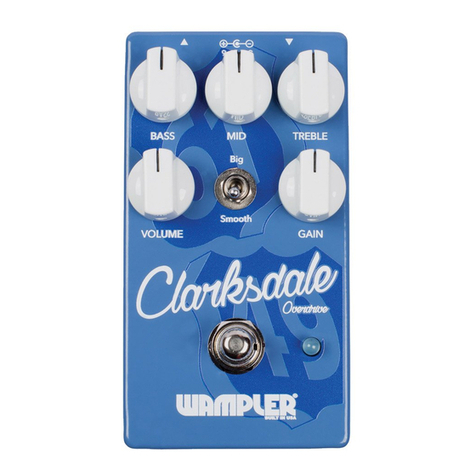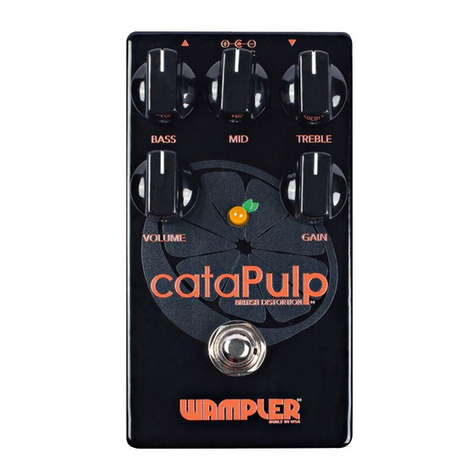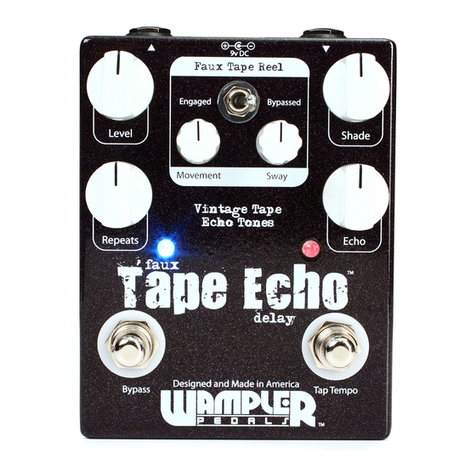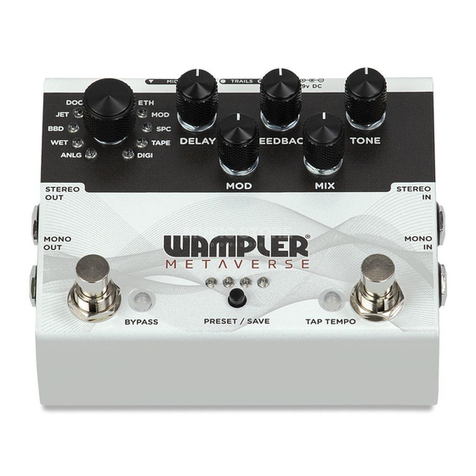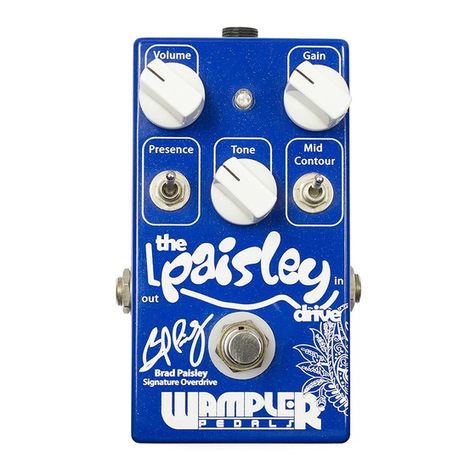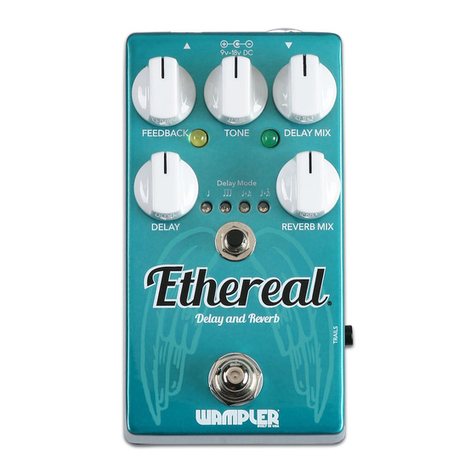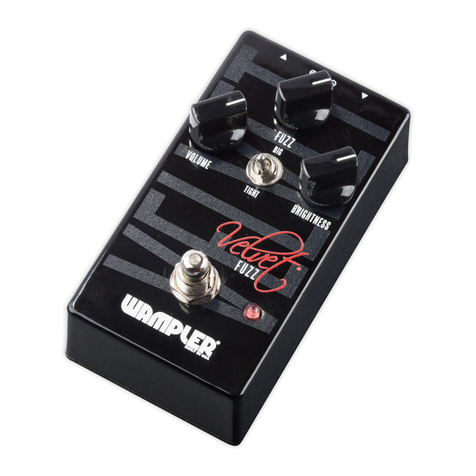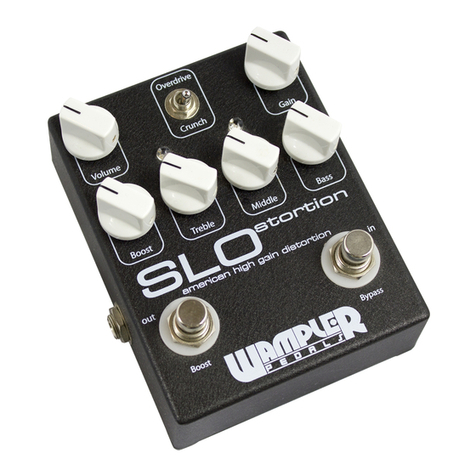
Bass – Adjusts the amount of bass applied to the eected signal. If you are
using an “S style”single coil guitar rather than a humbucker loaded
instrument, you may nd you need more bass to“fatten” up the tone.
When in the fully counterclockwise position, the tone will be much
thinner and brighter and when fully clockwise it will be fuller, darker and
heavier around the low end.
Treble – Works in the same way as the bass knob but controls the amount
of treble on the eected signal. Again, fully counterclockwise the treble is
reduced considerably and clockwise brings it forward. You may have to
tweak both the treble and bass controls simultaneously to nd your sweet
spot.
Top Cut – Just like the original ampliers that inspired this pedal, the top
boost can be used to tame some of the high end; by denition this pedal
is very bright. With that said, if you have a bright sounding amp/guitar you
may need to adjust accordingly to compensate for some of the high
tones. When the knob is fully counterclockwise the entire range of highs is
allowed through. As you turn the knob clockwise the highs are cut more.
Gain – Increases the amount of overdrive produced by the pedal. When
fully counterclockwise there is no additional gain applied. As the gain
knob is turned clockwise, the amount of gain correspondingly increases.
This control works very closely with the “headroom”switch. You will notice
more of a pronounced midrange hump as the gain is increased. This eect
is extremely accurate to the sound of how the original amps reacted/
sounded when being driven!
Volume - Adjusts the output volume of the eected signal. Fully counter-
clockwise is “o ” and clockwise is considered to be “wide open”!
Boost Level - Adjusts the amount of volume that is applied before the
main gain circuits. Like the volume control, counterclockwise is “o ” and
clockwise is “full”. When the main pedal is not activated, this will act as an
independent Class-A booster.
Headroom - Gain stage control. When in the “30” position, there is more
headroom and the pedal takes longer across the gain control sweep to
reach a saturated overdrive. This gives you a broader range of clean and
lightly overdriven tones. When in the“15”position, the headroom is much
lower and the overdrive arrives much quicker; this gives you the greater
option of overdriven tones. Just keep in mind that the gain knob should
be used in conjunction with this control!
Power Requirements
The pedal can be powered by a 9V battery. The battery terminal is located inside the pedal. If
using a power supply, power needed for the pedal is 9V DC, regulated, center pin negative, as
supplied by most standard Boss™/Ibanez™/Etc. supplies. The pedal can be safely powered with a
multi-supply, like the Visual Sound 1SPOT™. The pedal was designed explicitly around the usage
of a 9V DC power source, and is intended to sound its best at 9V. To avoid damage to the pedal,
do not exceed 9V DC, do not use center pin positive adapters, and do not use AC power. Using an
incorrect power adapter can lead to damage and will void the warranty on the pedal. This pedal
draws 13mA.
Please note: If you are using a battery, it will drain when the input cord is plugged in.
Return and Warranty Policy
For direct sales, there is a 7-day “no questions asked” period where you may return the pedal for any reason, provided that it is in its original condition. Please retain
all packaging within this period in case you decide to return it! We only require that you pay shipping back. The 7 days start when you receive the pedal. This does
not apply to dealer or retailer sales – see their individual return policies for specic information.
All Wampler Pedals, Inc. pedals carry a 5-year, fully transferable warranty that covers defects due to parts and labor. The warranty begins at the point of purchase.
Please remember to register your pedal as soon as possible after purchase at the following web page to ensure quicker service if you should ever need to make a
warranty claim: www.wamplerpedals.com/warranty_registration
For warranty repairs or questions, please feel free to contact us at www.wamplerpedals.com/contact_us.html
Chimey, alive and crystal clear. The pop band to end all pop
bands. Boost OFF, volume to suit (to give it“Shadow”, increase
cut to around“3pm”.
A Shadow of the Fab Four
May your tone be Regal.
A punchy overdriven tone, heard on classic studio album
from one of the biggest bands of the 70’s, 80’s and 90’s. Boost
ON, volume to suit.
Let’s get Petty
If you want to be a Heartbreaker, you need the tone. Boost
OFF, volume to suit. (dependent on your guitar, you may need
to increase the“Top Cut” a touch.
Edgy Bloody Sunday (live).
Percusive and full of attack, just the right amount of grit,
compression and brightness to cut the guitars through any mix
without any delay. Boost ON, volume to suit (for studio tones,
turn the boost o).
Suggested Settings
Any trademarks attributed that are not owned by Wampler Pedals, Inc. are for
demonstrative purposes only, and are property of their respective owners

